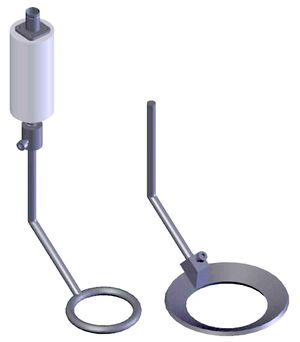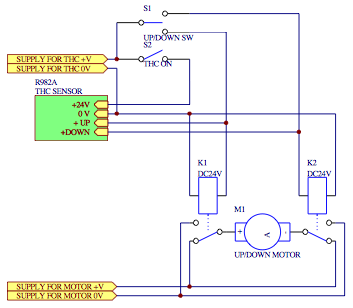Sensing Distance from Work Piece
Quality of product depends on the ability to detect the distance of the cutting tool from the Work Piece. The nature of this sensing problem changes depending on the cutting tool.
Ultrasound ranging may provide general-purpose sensing, independent of the specific tool type.
Torch cutting
See also Paul Log capacitance sensor
See also Height_Controller
Plasma Torch
See also Justin log
Here is a great article on controlling Torch to Work Distance. The quick story is that voltage between the torch and the work piece increases as the torch gets further away from the material. There is a discussion of building a z-controller here-- some of the content may be helpful. From that is a potential collaborator.
Documentation on torch height control in Linux CNC. Centers around use of the THC 300, which appears to no longer be available, and the CandCNC units. Note that CandCNC claims to only work with Mach3 and offers a $250 stand-alone torch height controller.
Experimental data points (Feb 2013, ChuckH): Hypertherm torch on Torchmate plasma cutter
- cutting 1/4" mild steel, 60A current setting, arc voltage approx 137V
- cutting 12ga mild steel, 40A current setting, arc voltage approx 125V
- approx 1 volt arc voltage change per 1/16 inch height change (very approximate guess).
Experimental observation (ChuckH): The Torchmate cutter sets initial height by using the (DC-servo-driven) z axis to drive the torch into contact with the work and stalling (exceeding a torque/current sensing threshold), then retracting to pierce height. If the workpiece is bowed up or not fully supported, it deflects downward during the height detection and springs back up as the torch retracts; this situation results in the torch starting too close to the work. A lower-force or non-contact initial height sensor would avoid this problem.
There is a lot of information about torch tables using plasma torches, less about those using acetylene torches.
The articles about plasma torches seem consistent:
- Torch height should be regulated to optimize cut pattern:
- If too high or too low, the cut will have beveled edges
- Most torch head damage results from head too low
- Initial torch height should be 150% - 200% of height after cutting has been initiated.
- Height can be sensed by voltage of plasma arc: Torch height is proportional to arc voltage. Open circuit voltage is around 300vdc, cutting voltage ranges from 80vdc to 200vdc, depending on operating current and cutting height.
Relevant articles:
Oxyfuel Torch Technology
Torch tables using flame technology abound as well. They are called "Oxygen Fuel" tables, as they can use fuels other than acetylene.
Capacitive Height Controllers induce a high frequency signal between a sensor ring and the subject steel and measure the resulting capacitance. This capacitance is inversely proportional to the distance between the sensor ring and the steel surface. The controller uses this measurement to generate signals to control a motor to adjust the head height.
Agelkom uses two rings to control head height for both plasma and oxy fuel torches:
- Plasma ring
- Dimensions: 34 mm ID, 47 mm OD
- Head height: 1.5 - 10 mm
- Fuel ring
- Dimensions: 50 mm ID, 69 mm OD
- Head height: 7 - 35 mm
Sensing rings must be electrically isolated from all conductive parts.
The Rutex controller employs two relays to drive a single motor to control the up/down positioning of the torch head as in the following diagram:
Data sheets on a controllers for controlling the head height on an oxygen fuel system:
Other torch height sensor ideas
- Capacitive sensors
- Cypress PSoc4 proximity demo, PSoC Torch Height Sensing
- Capacitive sensors have been interfaced with arduinos
- Jcc3inc's torch height control (doesn't include initial height)
- [Sharp] photoelectric rangers might work for initial height sensing; presumably would be blinded during actual cutting.
- ultrasonic distance sensing: if mounted some distance from the torch, an ultrasonic sensor controlled by an arduino running the z-axis motor might be a low-cost way to control torch height. One might provide an input signal from the CNC-controlling computer (or cheat, and use a photocell aimed at torch location) to set pierce height differently than ongoing cut height.
- From the PING sensor datasheet:
- For accuracy, temperature compensation should occur.
- Maximum operating temperature of 70C.
- Minimum distance 2 cm (sensor should be mounted higher than tip of torch)
- [P.A.D.S], a bit more sophisticated than PING
- [Maxbotix] ultrasound sensor
- See also Ultrasound_Torch_Height_Controller
- From the PING sensor datasheet:
- industrial-grade, extreme environment capacitive sensors are also available
- stepper motor control with an arduino
- servo motor control with an arduino
- integrate with torch table grbl

